Enhanced Distributed Coordinated Control Strategy for DC Microgrid Hybrid Energy Storage Systems Using Adaptive Event Triggering
Abstract
1. Introduction
- First integration of an adaptive event-triggered mechanism with ANN-based hierarchical control for HESSs in DC microgrids.
- ANN architecture that simultaneously optimises voltage regulation (±0.5%) and current sharing (98% accuracy).
- Lyapunov-stable distributed coordination resilience to line resistance variations.
- Experimental validation of real-time feasibility on embedded hardware.
2. Architecture of an Islanded DC MG
- Distributed voltage consensus via (2);
- Current sharing coordination via (3);
- Trigger event broadcasting when > 0.
3. ANN-Based Distributed Coordinated Control Strategy for DC Microgrid HESSs Using Adaptive Event Triggering
3.1. ANN-Hierarchical Coordinated Control Structure of the HESS Based on the Adaptive Event-Triggering Mechanism
3.1.1. Artificial Neural Network
3.1.2. Droop and Distributed Control Model
- Dataset: 10,000 Simulink samples (load steps/PV ramps);
- Inputs;
- Voltage ANN: ;
- Current ANN: ;
- Compensation ANN: (Equation (3));
- Outputs: PWM duty cycles for converters;
- Training: Levenberg–Marquardt (5000 epochs) with early stopping at MSE < 1 × 10−5;
- Hardware: Weights exported to Cortex-M7 (0.8 ms inference time).
3.1.3. Adaptive Event-Triggering Control
4. Simulation Validation and Analysis
5. Conclusions
Author Contributions
Funding
Data Availability Statement
Conflicts of Interest
References
- Khodadoost Arani, A.A.; Gharehpetian, G.B.; Abedi, M. Review on Energy Storage Systems Control Methods in Microgrids. Int. J. Electr. Power Energy Syst. 2019, 107, 745–757. [Google Scholar] [CrossRef]
- Pashajavid, E.; Ghosh, A. Frequency Support for Remote Microgrid Systems with Intermittent Distributed Energy Resources—A Two-Level Hierarchical Strategy. IEEE Syst. J. 2018, 12, 2760–2771. [Google Scholar] [CrossRef]
- Zanib, N.; Batool, M.; Riaz, S.; Nawaz, F. Performance Analysis of Renewable Energy Based Distributed Generation System Using ANN Tuned UPQC. IEEE Access 2022, 10, 110034–110049. [Google Scholar] [CrossRef]
- Ghasemi, N.; Ghanbari, M.; Ebrahimi, R. Intelligent and optimal energy management strategy to control the Micro-Grid voltage and frequency by considering the load dynamics and transient stability. Int. J. Electr. Power Energy Syst. 2023, 145, 108618. [Google Scholar] [CrossRef]
- Lei, T.; Riaz, S.; Zanib, N.; Batool, M.; Pan, F.; Zhang, S. Performance Analysis of Grid-Connected Distributed Generation System Integrating a Hybrid Wind-PV Farm Using UPQC. Complexity 2022, 2022, 4572145. [Google Scholar] [CrossRef]
- Cabrane, Z.; Ouassaid, M.; Maaroufi, M. Battery and supercapacitor for photovoltaic energy storage: A fuzzy logic management. IET Renew. Power Gener. 2017, 11, 1157–1165. [Google Scholar] [CrossRef]
- Guo, T.; Liu, Y.; Zhao, J.; Zhu, Y.; Liu, J. A dynamic wavelet-based robust wind power smoothing approach using hybrid energy storage system. Int. J. Electr. Power Energy Syst. 2020, 116, 105579. [Google Scholar] [CrossRef]
- Zhao, H.; Guo, W. Coordinated control method of multiple hybrid energy storage systems based on distributed event-triggered mechanism. Int. J. Electr. Power Energy Syst. 2021, 127, 106637. [Google Scholar] [CrossRef]
- Su, H.; Zhang, J.; Wang, N.; Guo, W. Energy Management Strategy of Large-scale Hybrid Energy Storage System Based on Layered Optimization. Gaodianya Jishu/High Volt. Eng. 2018, 44, 1177–1186. [Google Scholar] [CrossRef]
- Xu, Q.; Xiao, J.; Wang, P.; Pan, X.; Wen, C. A Decentralized Control Strategy for Autonomous Transient Power Sharing and State-of-Charge Recovery in Hybrid Energy Storage Systems. IEEE Trans. Sustain. Energy 2017, 8, 1443–1452. [Google Scholar] [CrossRef]
- Lin, P.; Wang, P.; Xiao, J.; Wang, J.; Jin, C.; Tang, Y. An Integral Droop for Transient Power Allocation and Output Impedance Shaping of Hybrid Energy Storage System in DC Microgrid. IEEE Trans. Power Electron. 2018, 33, 6262–6277. [Google Scholar] [CrossRef]
- Zhang, W.; Chen, J.; Riaz, S.; Zheng, N.; Li, L. Research on Distributed Cooperative Control Strategy of Microgrid Hybrid Energy Storage Based on Adaptive Event Triggering. CMES—Comput. Model. Eng. Sci. 2022, 131, 585–604. [Google Scholar] [CrossRef]
- Liu, X.K.; He, H.; Wang, Y.W.; Xu, Q.; Guo, F. Distributed hybrid secondary control for a DC microgrid via discrete-time interaction. IEEE Trans. Energy Convers. 2018, 33, 1865–1875. [Google Scholar] [CrossRef]
- Dong, W.; Li, S.; Fu, X. Artificial Neural Network Control of A Standalone DC Microgrid. In Proceedings of the 2018 Clemson University Power Systems Conference (PSC), Charleston, SC, USA, 4–7 September 2018. [Google Scholar] [CrossRef]
- Li, S.; Fairbank, M.; Johnson, C.; Wunsch, D.C.; Alonso, E.; Proao, J.L. Artificial neural networks for control of a grid-Connected rectifier/inverter under disturbance, dynamic and power converter switching conditions. IEEE Trans. Neural Netw. Learn. Syst. 2014, 25, 738–750. [Google Scholar] [CrossRef]
- Lopez-Garcia, T.B.; Coronado-Mendoza, A.; Domínguez-Navarro, J.A. Artificial neural networks in microgrids: A review. Eng. Appl. Artif. Intell. 2020, 95, 103894. [Google Scholar] [CrossRef]
- Ronay, K.; Bica, D.; Munteanu, C. Micro-grid Development Using Artificial Neural Network for Renewable Energy Forecast and System Control. Procedia Eng. 2017, 181, 818–823. [Google Scholar] [CrossRef]
- Moosavi, S.S.; Djerdir, A.; Ait-Amirat, Y.; Khaburi, D.A.; N’Diaye, A. Artificial neural network-based fault diagnosis in the AC–DC converter of the power supply of series hybrid electric vehicle. IET Electr. Syst. Transp. 2016, 6, 96–106. [Google Scholar] [CrossRef]
- Khan, H.S.; Mohamed, I.S.; Kauhaniemi, K.; Liu, L. Artificial Neural Network-Based Voltage Control of DC/DC Converter for DC Microgrid Applications. In Proceedings of the 2021 6th IEEE Workshop on the Electronic Grid (eGRID), New Orleans, LA, USA, 8–10 November 2021. [Google Scholar] [CrossRef]
- Nowzari, C.; Garcia, E.; Cortés, J. Event-Triggered Communication and Control of Networked Systems for Multi-Agent Consensus. Automatica 2017, 105, 1–27. [Google Scholar] [CrossRef]
- Fan, Y.; Hu, G.; Egerstedt, M. Distributed Reactive Power Sharing Control for Microgrids with Event-Triggered Communication. IEEE Trans. Control Syst. Technol. 2017, 25, 118–128. [Google Scholar] [CrossRef]
- Chen, M.; Xiao, X.; Guerrero, J.M. Secondary restoration control of islanded microgrids with a decentralized event-triggered strategy. IEEE Trans. Ind. Inform. 2018, 14, 3870–3880. [Google Scholar] [CrossRef]
- Abdolmaleki, B.; Shafiee, Q.; Seifi, A.R.; Arefi, M.M.; Blaabjerg, F. A Zeno-Free Event-Triggered Secondary Control for AC Microgrids. IEEE Trans. Smart Grid 2020, 11, 1905–1916. [Google Scholar] [CrossRef]
- Zhao, G.; Jin, L.; Wang, Y. Distributed Event-Triggered Secondary Control for Islanded Microgrids With Disturbances: A Hybrid Systems Approach. IEEE Trans. Power Syst. 2023, 38, 1420–1431. [Google Scholar] [CrossRef]
- Fan, B.; Peng, J.; Yang, Q.; Liu, W. Distributed Periodic Event-Triggered Algorithm for Current Sharing and Voltage Regulation in DC Microgrids. IEEE Trans. Smart Grid 2020, 11, 577–589. [Google Scholar] [CrossRef]
- Pullaguram, D.; Mishra, S.; Senroy, N. Event-Triggered Communication Based Distributed Control Scheme for DC Microgrid. IEEE Trans. Power Syst. 2018, 33, 5583–5593. [Google Scholar] [CrossRef]
- Han, R.; Meng, L.; Guerrero, J.M.; Vasquez, J.C. Distributed Nonlinear Control with Event-Triggered Communication to Achieve Current-Sharing and Voltage Regulation in DC Microgrids. IEEE Trans. Power Electron. 2018, 33, 6416–6433. [Google Scholar] [CrossRef]
- Qian, T.; Liu, Y.; Zhang, W.; Tang, W.; Shahidehpour, M. Event-Triggered Updating Method in Centralized and Distributed Secondary Controls for Islanded Microgrid Restoration. IEEE Trans. Smart Grid 2020, 11, 1387–1395. [Google Scholar] [CrossRef]
- Yan, H.; Han, J.; Zhang, H.; Zhan, X.; Wang, Y. Adaptive Event-Triggered Predictive Control for Finite Time Microgrid. IEEE Trans. Circuits Syst. I Regul. Pap. 2020, 67, 1035–1044. [Google Scholar] [CrossRef]
- Wang, Y.; Deng, C.; Liu, D.; Xu, Y.; Dai, J. Unified Real Power Sharing of Generator and Storage in Islanded Microgrid via Distributed Dynamic Event-Triggered Control. IEEE Trans. Power Syst. 2021, 36, 1713–1724. [Google Scholar] [CrossRef]
- Guo, F.; Wang, L.; Wen, C.; Zhang, D.; Xu, Q. Distributed Voltage Restoration and Current Sharing Control in Islanded DC Microgrid Systems without Continuous Communication. IEEE Trans. Ind. Electron. 2020, 67, 3043–3053. [Google Scholar] [CrossRef]
- Zhang, B.; Dou, C.; Yue, D.; Zhang, Z.; Zhang, T. A Packet Loss-Dependent Event-Triggered Cyber-Physical Cooperative Control Strategy for Islanded Microgrid. IEEE Trans. Cybern. 2021, 51, 267–282. [Google Scholar] [CrossRef]
- Cleveland, F.M. IEC 61850-7-420 communications standard for distributed energy resources (DER). In Proceedings of the 2008 IEEE Power and Energy Society General Meeting—Conversion and Delivery of Electrical Energy in the 21st Century, Pittsburgh, PA, USA, 20–24 July 2008. [Google Scholar] [CrossRef]
- Nawaz, F.; Fan, Y.; Pashajavid, E.; Sciences, M.; Batool, M. Hybrid Energy Storage System in DC Microgrids—An Enhanced Distributed Coordinated Control. In Proceedings of the 2024 IEEE International Smart Cities Conference (ISC2), Pattaya, Thailand, 29 October–1 November 2024. [Google Scholar]
- Rahman, M.M.; Shakeri, M.; Khatun, F.; Tiong, S.K.; Alkahtani, A.A.; Samsudin, N.A.; Amin, N.; Pasupuleti, J.; Hasan, M.K. A comprehensive study and performance analysis of deep neural network-based approaches in wind time-series forecasting. J. Reliab. Intell. Environ. 2023, 9, 183–200. [Google Scholar] [CrossRef]
- Vinnakoti, S.; Kota, V.R. ANN based control scheme for a three-level converter based unified power quality conditioner. J. Electr. Syst. Inf. Technol. 2018, 5, 526–541. [Google Scholar] [CrossRef]
- Zhou, M.; Wan, J.-R.; Wei, Z.-Q.; Cui, J. Control Method for Power Quality Compensation Based on Levenberg-Marquardt Optimized BP Neural Networks. In Proceedings of the 2006 CES/IEEE 5th International Power Electronics and Motion Control Conference, Shanghai, China, 14–16 August 2006; pp. 1–4. [Google Scholar] [CrossRef]
- Moré, J.J. The Levenberg-Marquardt algorithm: Implementation and theory. In Numerical Analysis; Lecture Notes in Mathematics; Springer: Berlin/Heidelberg, Germany, 1978; pp. 105–116. [Google Scholar] [CrossRef]
- Nasirian, V.; Moayedi, S.; Davoudi, A.; Lewis, F.L. Distributed cooperative control of dc microgrids. IEEE Trans. Power Electron. 2015, 30, 2288–2303. [Google Scholar] [CrossRef]
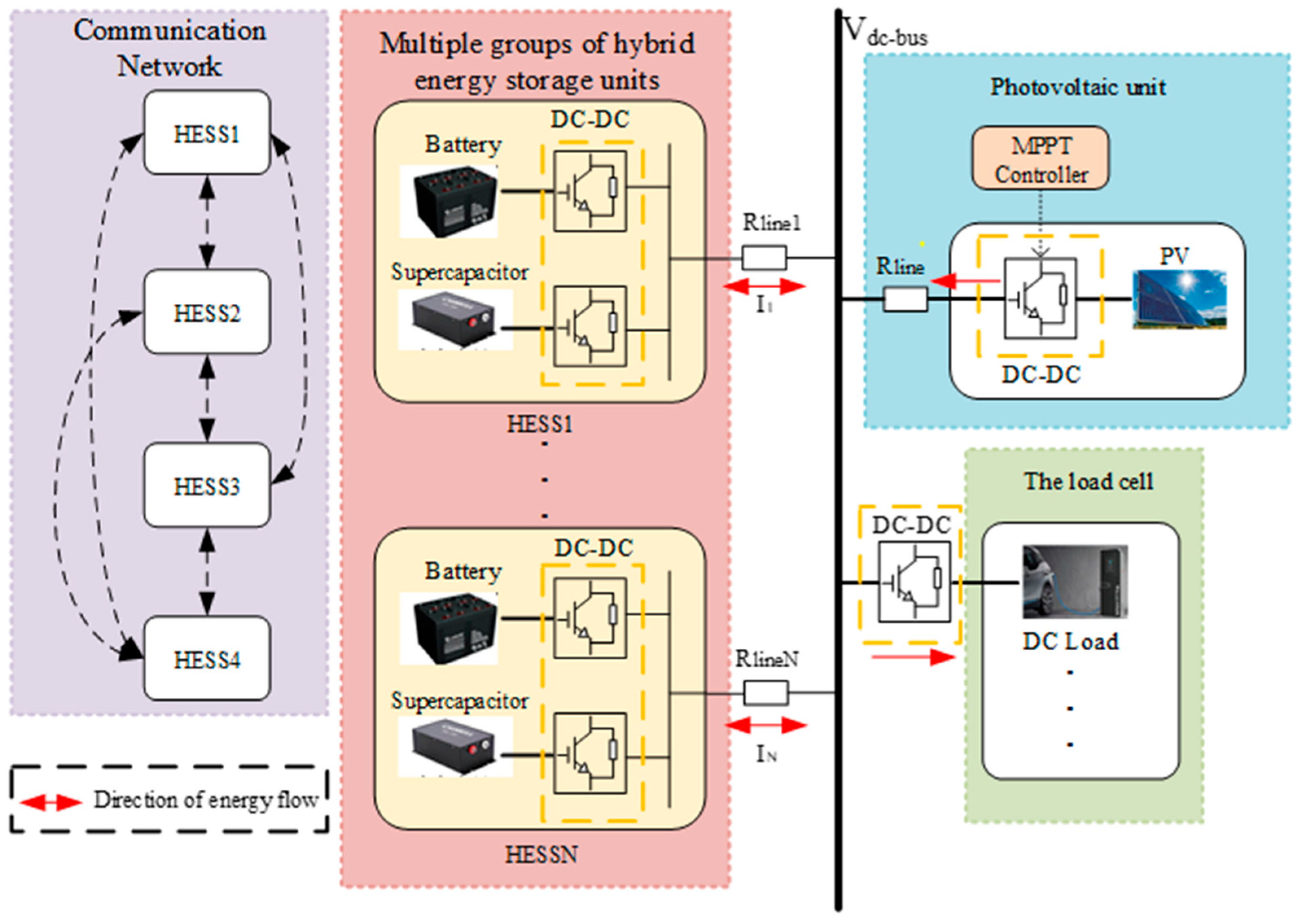

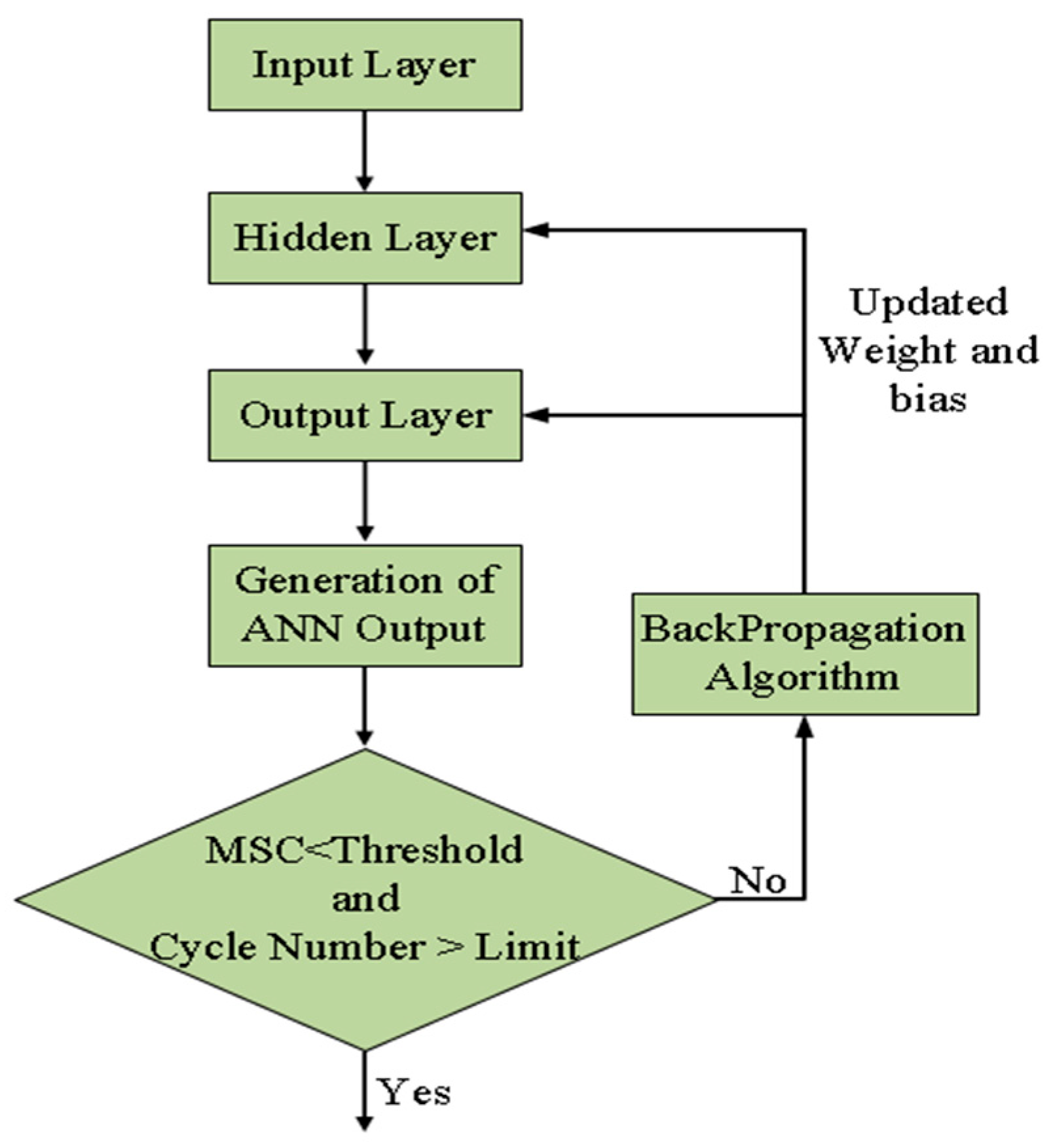
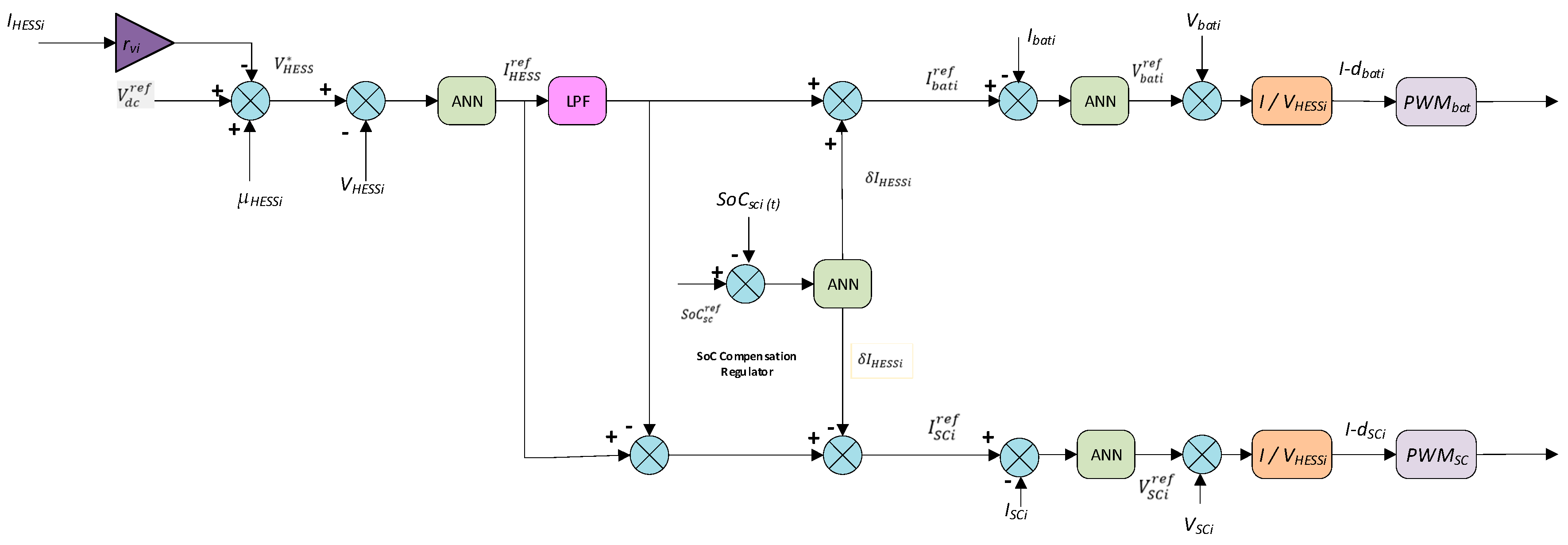

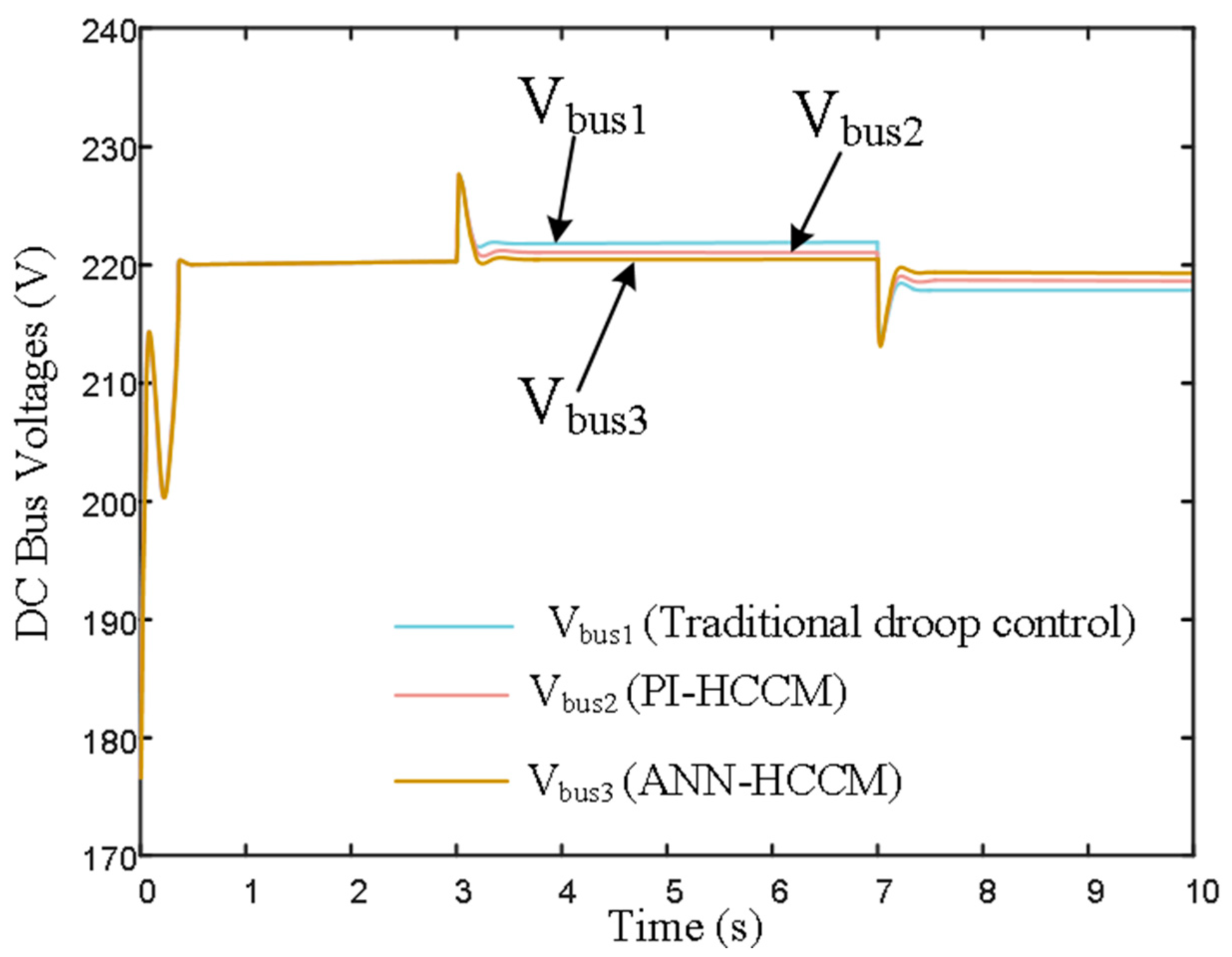
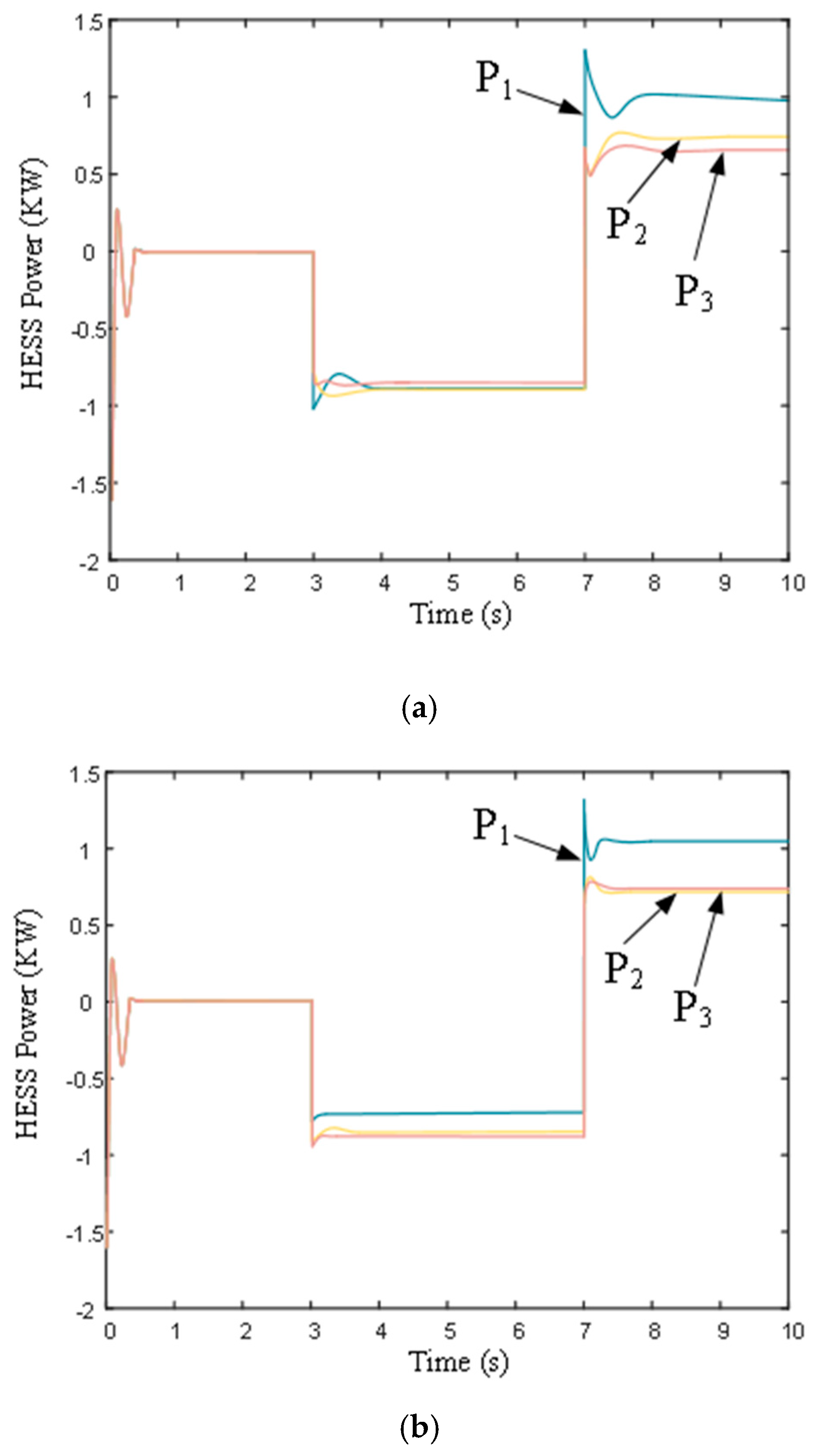
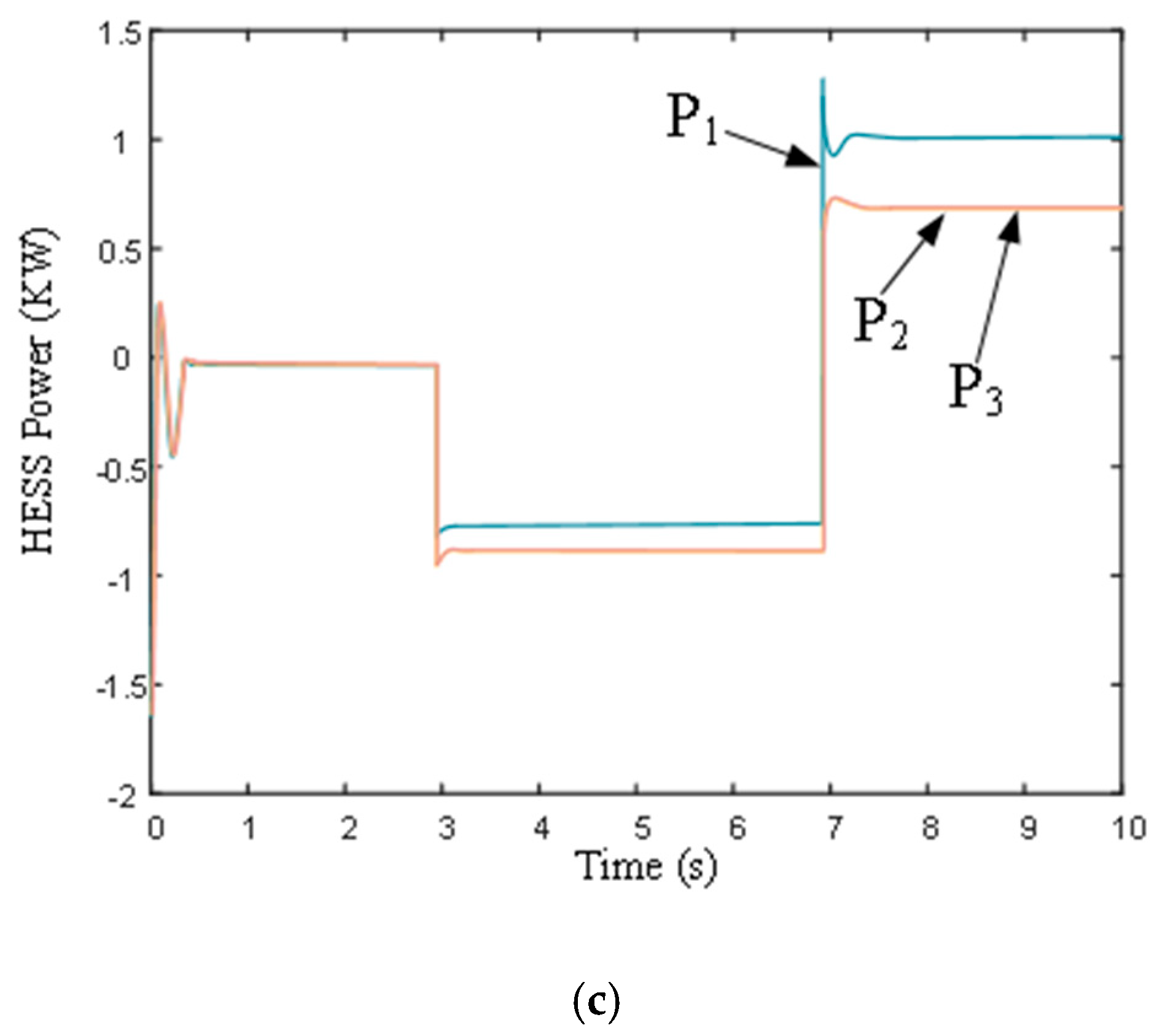

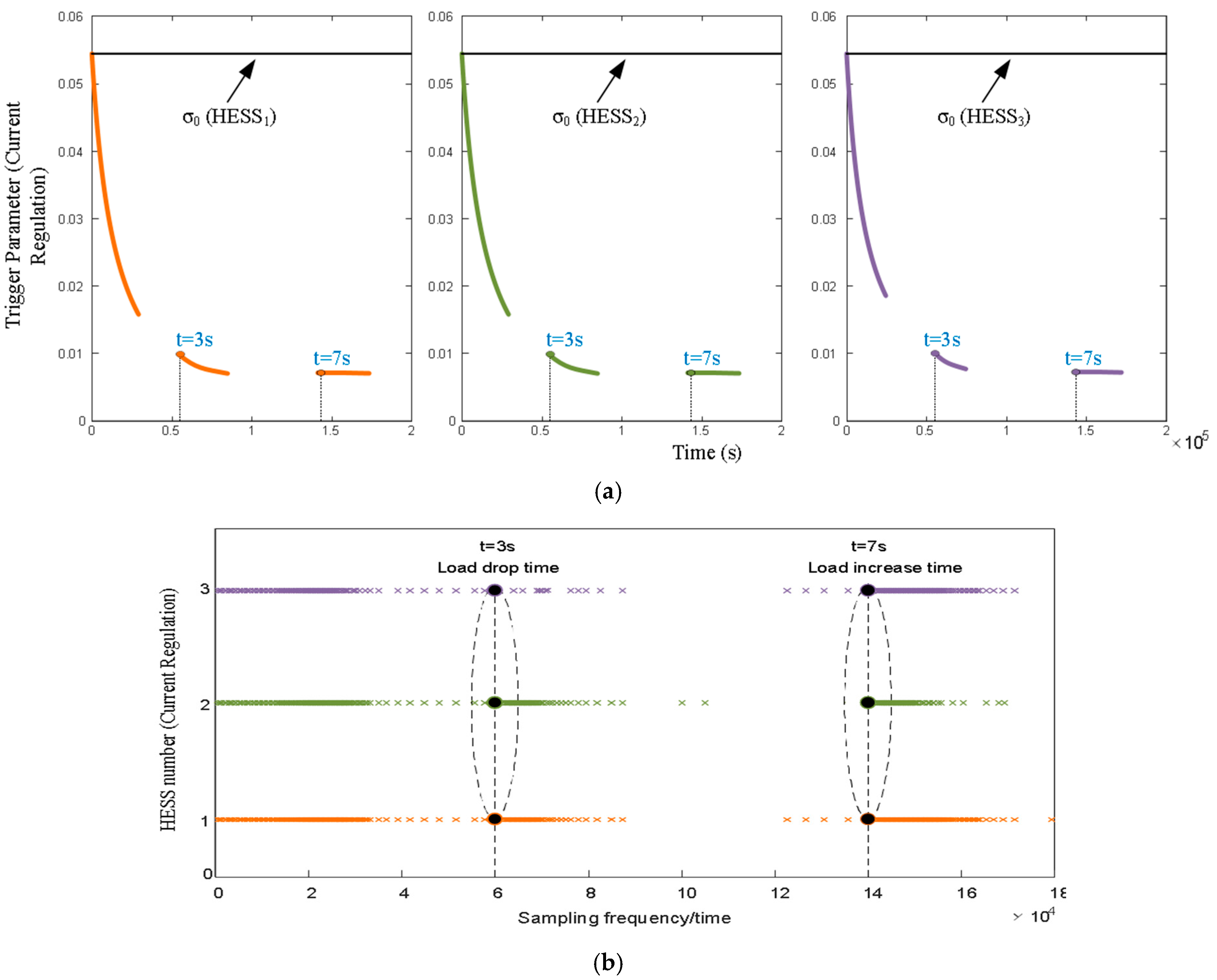

| Method | Training Data | Latency | Accuracy |
|---|---|---|---|
| ANN (This paper) | 10k samples | 0.8 ms | 98% |
| RL [28] | 1M steps | 5 ms | 95% |
| Parameters | Value |
|---|---|
| Rated Voltage of DC bus (V) | 220 |
| Line Impedance (Ω) | 0.10/0.12/0.14 |
| Max Virtual Resistance (Ω) | 0.2 Ω |
| Supercapacitor (V/F) | 96/82.5 |
| Battery (V/Ah) | 108/108 |
| Voltage Loop | KPV = 2.8; KIV = 92.2; |
| Battery Current Loop | KPbat = 22.4; KIbat = 32.7; |
| SC SoC Compensation | KPSoC = 300; KISoC = 0.4 ; |
| Supercapacitor Current Loop | KPSC = 1.4; KISC = 4.36; |
| σ0 | 0.06 |
| ρ | 0.0001 |
Disclaimer/Publisher’s Note: The statements, opinions and data contained in all publications are solely those of the individual author(s) and contributor(s) and not of MDPI and/or the editor(s). MDPI and/or the editor(s) disclaim responsibility for any injury to people or property resulting from any ideas, methods, instructions or products referred to in the content. |
© 2025 by the authors. Licensee MDPI, Basel, Switzerland. This article is an open access article distributed under the terms and conditions of the Creative Commons Attribution (CC BY) license (https://creativecommons.org/licenses/by/4.0/).
Share and Cite
Nawaz, F.; Pashajavid, E.; Fan, Y.; Batool, M. Enhanced Distributed Coordinated Control Strategy for DC Microgrid Hybrid Energy Storage Systems Using Adaptive Event Triggering. Electronics 2025, 14, 3303. https://doi.org/10.3390/electronics14163303
Nawaz F, Pashajavid E, Fan Y, Batool M. Enhanced Distributed Coordinated Control Strategy for DC Microgrid Hybrid Energy Storage Systems Using Adaptive Event Triggering. Electronics. 2025; 14(16):3303. https://doi.org/10.3390/electronics14163303
Chicago/Turabian StyleNawaz, Fawad, Ehsan Pashajavid, Yuanyuan Fan, and Munira Batool. 2025. "Enhanced Distributed Coordinated Control Strategy for DC Microgrid Hybrid Energy Storage Systems Using Adaptive Event Triggering" Electronics 14, no. 16: 3303. https://doi.org/10.3390/electronics14163303
APA StyleNawaz, F., Pashajavid, E., Fan, Y., & Batool, M. (2025). Enhanced Distributed Coordinated Control Strategy for DC Microgrid Hybrid Energy Storage Systems Using Adaptive Event Triggering. Electronics, 14(16), 3303. https://doi.org/10.3390/electronics14163303







